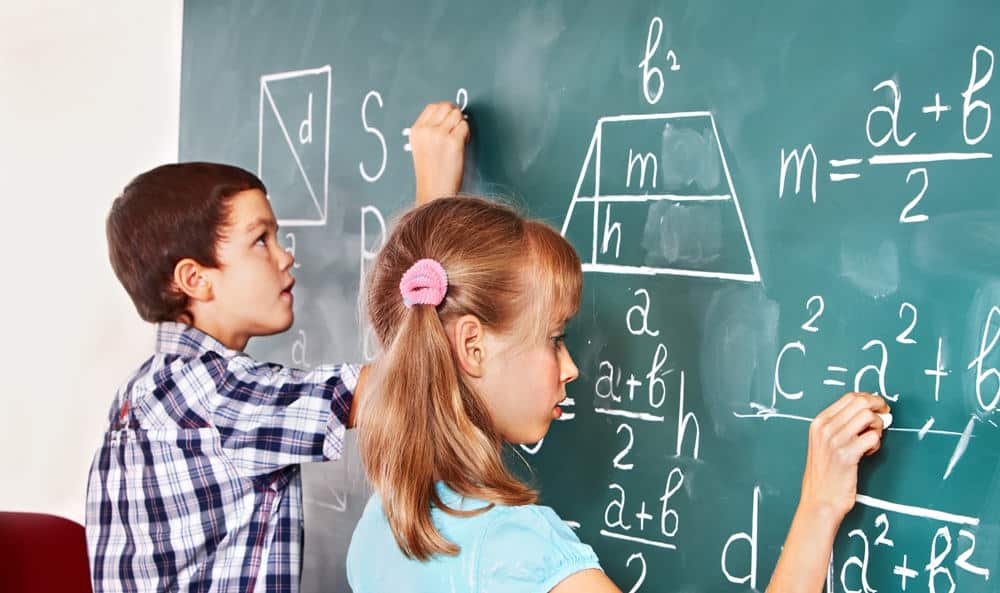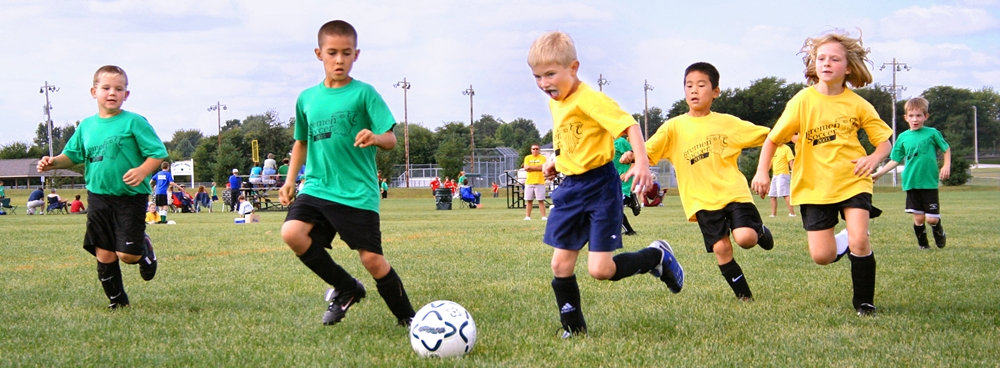In this article, we will answer the following question: Does exercise improve academic performance?
It is common to hear a certain social group talk about the subject of Physical Education as an area of little curricular and/or formative value for children.
Physical condition and academic performance
According to a recent study published in the journal Brain and Cognition, the physical condition of children in our schools is directly related to their cognitive ability.
It suggests that the greater their anaerobic abilities, the faster their neuronal connections or synapses will be, an aspect that will reflect in a considerable improvement in logical thinking and linguistic skills (1).
The present study conducted by Scudder and collaborators in the United States measured the neuronal activity of adolescents with diverse physical profiles through a technique called electroencephalography, obtaining results that aerobic capacity positively influences our brain function.
Thus, adolescents who were in good physical shape obtained better results in reading comprehension tests than those sedentary children.
If all this were not enough, researchers from the University of Illinois found that they were more decisive and faster when reading texts with syntactic or grammatical errors (1).
To demonstrate this, the research study (1) focused on exploring the brain’s responses (through electrical activity) of the N400 component, directly related to reading comprehension.
These studies, called ERPs (Event-Related Potentials), investigate another brain wave called P600, which is related to the verification of the grammatical rules of a sentence.
The speed and reach of these are what determine each person’s cognitive ability.
In a second part of the mentioned study (1), the researchers compared the academic performance of adolescents with the results obtained in the electroencephalograms, confirming again that those with better grades were also those with shorter N600 and P600 waves and therefore, those who presented greater aerobic capacity.
So… does physical exercise reduce school failure?
A recent study conducted at the Autonomous University of Madrid, published in the journal Journal of Pediatrics, analyzed more than 2,038 Spanish students aged 6 to 18 years and was able to demonstrate that exercise significantly improves school performance (2).
The study is based on the analysis of the records of the participating students and surveys about the physical activities each of them performed.
Subsequently, physical tests were conducted to measure their respiratory capacity, motor skills, and muscle tone. The researchers found that while muscle tone did not influence in any way, respiratory and motor capacity did have an impact on school performance (2).
What conclusions are drawn from this study?
On one hand, respiratory capacity and motor capacity are positively associated with academic performance in young people and on the other hand, the combination of both reports greater benefits in said performance.
In contrast, muscle capacity has not been seen to have either harmful or beneficial effects on academic performance in young students (2).
Motor capacity is associated with an increase in the number of synapses, which produces an improvement in cognitive control, and this cognitive control is associated with academic performance (2).
We could therefore say that if our young people engage in physical activity that improves these physical capacities, they can benefit from better academic performance.
In addition, the World Health Organization (WHO) recommends that children aged 5 to 17 engage in at least 60 minutes a week of exercise at a moderate to vigorous intensity.
This activity should be primarily aerobic, and it would be advisable to add vigorous activities that strengthen muscles at least three times a week. (3).
Young people who engage in physical activity achieve better academic performance
Memory training: key to cognitive control
Memory work is considered a key aspect of cognitive control (6), as individuals need it to temporarily maintain and manipulate information in their minds and to choose goal-directed behaviors in a variety of cognitive contexts.
For school-aged children, several studies have shown that working memory is associated with academic performance in subjects like mathematics and reading (1,7,12).
Therefore, several studies attempted to examine whether the effects of a physical activity program would improve working memory performance.
This would support the importance of physical activity for cognitive development and provide a basis for the development of academic performance (4,9).
It has been observed that adults slow down their response speed during work conditions that require a greater amount of cognitive control to preserve response accuracy, while children tend to maintain a more constant response speed regardless of cognitive control demands due to their impulsive tendency (3,6).
But… does exercise really improve academic performance?
In another study, 43 children aged 7 to 9 were randomly assigned to participate in a physical activity program (after-school activities) (intervention group; n = 22) or in a control group (no physical activity; n = 21).
None of the children received special education or services related to cognitive or attention disorders.
Physical activity intervention
The physical activity intervention took place during a 2-hour period after each school day, and focused on improving cardiorespiratory capacity through participation in a variety of age-appropriate physical activities.
Although cardiorespiratory capacity was the focus of interest, gym training was planned at least 2 days a week: using their own body, Thera-bands, medicine balls, and other resistance materials.
Within a session, the children participated intermittently in at least 70 minutes of vigorous physical activity (recorded by E600 Polar heart rate [HR]; Polar Electro, Finland).
Then, a healthy snack and a rest period followed, and the children then dedicated a 40-minute period to skill exercises.
The activities were aerobically demanding, but always simultaneously with motor skill development activities. On weekends, children were encouraged to continue their participation in physical activities with their family.
Cardiorespiratory condition assessment
The maximum oxygen consumption (VO2max) was measured using a treadmill and the modified Balke test (5), which involved walking/running on a treadmill at a constant speed with increasing speed increments of 2.5% every 2 min until exhaustion.
Oxygen consumption was measured using a computerized indirect calorimetry system (Parvomedics Max 2400) with averages of VO2 and the respiratory exchange ratio (RER) evaluated every 20 s.
A heart rate monitor (Polar WearLink + 31; Polar Electro, Finland) was used to measure HR throughout the test, and the perceived exertion index (RPE) was evaluated every 2 minutes using the OMNI scale.
Cognitive assessment
The modified Sternberg test was administered, which consisted of memorizing letter matrices and recognizing whether the loose letters that appeared afterward were in the previous matrix or not.
Results
VO2max in the post-test was significantly higher than in the pre-test for the intervention group, t (19) = 4.6, p <0.001, while no difference was observed for the control group, t (14) = 0.8, p = 0.45, confirming the effectiveness of the physical activity intervention (see Table 1 and Figure 1)
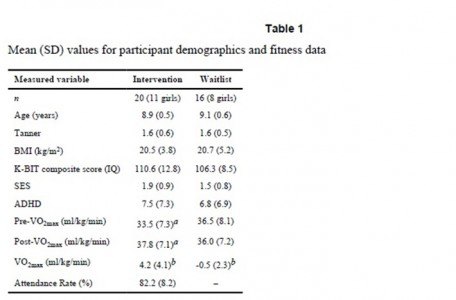
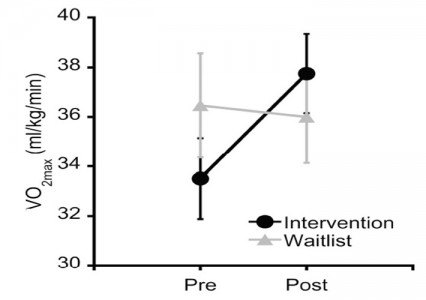
The post-cognitive analyses (p = 0.025) indicated that response accuracy in the post-test was greater than in the pre-test for the intervention group, t (19) = 3.6, p = 0.002, while there was no such difference for the control group, t (19) = 0.1, p = 0.9 (Figure 2).
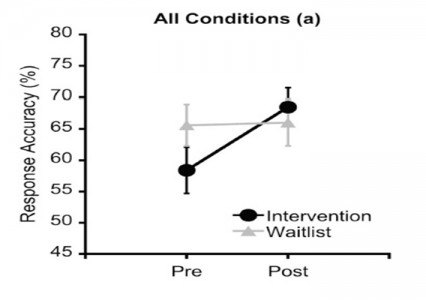
Conclusions
The main results indicate that the increase in cardiorespiratory capacity as a result of the physical activity intervention led to improvements in overall response accuracy in the cognitive memory test, an effect not observed for the control group.
The EEG (electroencephalogram – a non-invasive test that allows the study of brain electrical activity) results suggest that physical activity training can improve the efficiency of the fronto-parietal network in support of working memory.
Such a finding is especially interesting given the prolonged maturation of this neural network during preadolescent development.
In summary, physical activity improves working memory in preadolescent children, as reflected in greater response accuracy and greater CNV (Contingent Negative Variation – expectancy waves that are a physiological expression of the psychological activity of waiting or expecting a stimulus) in this study.
Memory is a crucial function of academic activities that form the basis for learning, and therefore this goes hand in hand with school performance (4,16).
Therefore, the present results support previous findings indicating a positive relationship between cardiorespiratory capacity and academic performance (8).
The present study indicates that regular physical activity leading to improvements in cardiorespiratory fitness is closely related to cognitive and brain health and can enhance cognitive development in preadolescent children.
References
- Scudder, M.R., Ferermeier, K.D., et al. (2014). The association between aerobic fitness and language processing in children: Implications for academic achievement. Brain and Cognition 87(1): 140-152.
- Esteban Cornejo, I., Tejero González, C.M et al. (2014). Independent and combined influence of the components of physical fitness on academic performance in youth. Journal of Pediatrics 165(2):306-312.
- World Health Organization (WHO). Physical activity in young people. Retrieved [online] on 18/02/2015.
- Alloway TP, Gathercole SE, Adams AM, Willis C, Eaglen R, Lamont E. (2005): Working memory and phonological awareness as predictors of progress towards early learning goals at school entry. British Journal of Developmental Psychology 23:417–426
- American College of Sports Medicine (2006.): ACSM’s guidelines for exercise testing and prescription. 7th edn.. New York: Lippincott Williams & Wilkins.
- Christakou A, Halari R, Smith AB, Ifkovits E, Brammer M, Rubia K. (2009): Sex-dependent age modulation of frontostriatal and temporo-parietal activation during cognitive control. NeuroImage. 48:223–236.
- Coe DP, Pivarnik JM, Womack CJ, Reeves MJ, Malina RM. (2006): Effect of physical education and activity levels on academic achievement in children. Medicine and Science in Sports and Exercise. 38:1515–1519.
- Department of Health and Human Services, & Department of Education (2000.): Promoting better health for young people through physical activity and sports. A Report to the President from the Secretary of Health and Human Services and the Secretary of Education. Silver Spring, MD: Centers for Disease Control.
- Diamond, A. (2006): The early development of executive functions. In: Bialystok, E.; Craik, FIM., editors. Lifespan cognition: Mechanisms of change. New York: Oxford University Press: 70-95.
- Gathercole SE, Pickering SJ, Knight C, Stegmann Z. (2004): Working memory skills and educational attainment: evidence from national curriculum assessments at 7 and 14 years of age. Applied Cognitive Psychology. 18:1–16
- Hillman CH, Buck SM, Themanson JR, Pontifex MB, Castelli DM. (2009): Aerobic fitness and cognitive development: event-related brain potential and task performance indices of executive control in preadolescent children. Developmental Psychology. 45:114–129.
- Hillman CH, Castelli DM, Buck SM. (2005): Aerobic fitness and neurocognitive function in healthy preadolescent children. Medicine and Science in Sports and Exercise. 37:1967–1974.
- Hillman CH, Erickson KI, Kramer AF. (2008): Be smart, exercise your heart: exercise effects on brain and cognition. Nature Reviews Neuroscience. 9:58–65.
- Kramer AF, Hahn S, Cohen NJ, Banich MT, McAuley E, Harrison CR, Chason J, Vakil E, Bardell L, Boileau RA, Colcombe A.(1999): Ageing, fitness and neurocognitive function. Nature. 400:418– 419.
- Silva-Pereyra J, Fernández T, Harmony T, Bernal J, Galán L, Díaz-Comas L, Fernández-Bouzas A, Yáñez G, Rivera-Gaxiola M, Rodríguez M, Marosi E. (2001): Delayed P300 during Sternberg and color discrimination tasks in poor readers. International Journal of Psychophysiology. 40:17–32.
- Ting-Chien, Keita Kamijo, Matthew B. Pontifex, Kevin C. O’Leary, Mark R. Scudder (2011): The effects of an afterschool physical activity program on working memory in preadolescent children. Dev Sci 14(5): 1046–1058. doi:10.1111/j.1467-7687.2011.01054.x.
